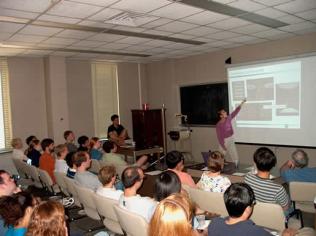Introduction
Former director of the English Teaching Theatre, Ken Wilson is a highly experienced
teacher, teacher-trainer and author of more than thirty ELT titles. Indeed, Wilson’s
collection of songs, ‘Mister Monday’, was released when he was just 23, making him
the youngest ever published ELT author at the time.
Appreciating that engaging students’ interest is not always straightforward, his
seminar identified ten techniques a teacher can employ to motivate learners.
Citing the work of Zoltán Dörnyei, who he claimed has done more research in this field
than anyone else, Wilson outlined the six key motivational factors that the Hungarian
identifies as having the most significant bearing on a student’s motivation in the
classroom-
1. Teacher enthusiasm
2. Feeling of encouragement from the teacher
3. A sense that the teacher really believes in the student’s progress and success
4. Genuine involvement of the teacher, maintaining good class and group
relationships
5. Supportive, safe and secure atmosphere
6. Valuing student ideas and participation, encouraging autonomy, giving students
the chance to make the classroom space their own
It was fascinating to note that of all these facets, it was teacher enthusiasm that came
out on top. Is the key to unlocking students’ talent really so firmly placed in the hands
of the teacher and governed by the degree of passion they exhibit relating to the job
they do? Wilson augmented Dörnyei’s findings by recalling Steve Jobs’ maxim that
“The only way to do great work is to love what you do.”
Wilson accepted that maintaining this enthusiasm can be a challenge, given the fear,
anxiety and exhaustion that imbue teachers’ hectic schedules!
In any case, Wilson averred, zeal can only take the teacher so far and it should be
coupled with stringent efforts to devolve power in the classroom where appropriate.
Wilson’s Ten Ways To Motivate Students
Wilson proceeded to present his ten strategies of how best to generate motivated and
self-driven learners, employing the Spring Gardens audience as his students for the
evening.
1. Make them curious
Shown a photograph of a man pushing his head through the spokes of a bicycle
wheel, the audience were invited to verbalise their initial response in pairs and then
feed back to the whole group. “Ouch” was the most popular response!
Having aroused our curiosity with an arresting image, the ‘class’ were keen to learn
more. Wilson then provided more details about the photograph and described its
context. The man pictured was Michel Lotito, perhaps better known as ‘Monsieur
Mangetout’. The photo documented his successful attempt to eat a bicycle, a feat he
accomplished in six days!
What, Wilson asked, do you think was the most difficult part of the bicycle to
consume? Returning to their pairs, the audience ruminated further, before related
vocabulary was displayed on the board and opinions were shared. Wilson defined
these activities as pre-reading exercises prior to detailed biographical information
relating to Lotito being displayed on the board. (The tyres are apparently the most
testing to eat!)
Wilson revealed how he has been successfully utilising headlines and articles from the
National Inquirer, Weekly World News and Yahoo! for many years to similar effect.
Wilson’s mantra was clear- if you feel engaged by a reading text then it is very likely
that your students will too.
2. Challenge them
The audience were invited to stand up and form groups of five. Having numbered
each member of their group one to five, Wilson then displayed two sets of five
questions. Number 1s would be asked to read and recall the information contained in
points 1 and 6, Number 2s in points 2 and 7, etc. The information was projected
fleetingly. Groups were then challenged to collate as many of the details they had
recalled as possible. This proved very exacting but great fun nonetheless!
The material related to US Presidents Lincoln and Kennedy and the unnerving
similarities between their tenures in office and the nature of their assassinations.
This had been another incredibly engaging way of delivering a pre-reading activity.
Ten bullet-points could be extracted from most reading tasks and delivered in this way
as a fun memory exercise. Moreover, the mechanics of the activity itself served as an
exceedingly effective way of getting learners up out of their seats and working
together as a team. Particularly during evening classes, Wilson maintained, students
can feel tired. In pushing the learners out of their comfort zone, tasks of this nature
serve to revitalise and reengage them.
3. Avoid the obvious
ELT textbooks generally succumb to the temptation of using celebrities from the
worlds of film, music and sport to adorn their pages. Wilson highlighted the pit-falls of
this strategy by taking David Beckham as an example and charting his variable
hairstyles. In attempting to be ‘current’, course books can all too quickly appear like
yesterday’s news and seem outdated before they have even reached the shelves.
Living celebrities are a problem. Biographical information and physical appearances
change frequently.
Celebrities, Wilson claimed, should be shunned in favour of more human interest
stories, illustrated by the account of Bethany Hamilton, a surfer who lost her arm
following a shark attack but was back in the water four weeks later continuing to enjoy
her passion.
When considering student engagement, stories of this kind are a more potent force,
Wilson declared.
4. Devolve responsibility
All classes are mixed ability, Wilson attested. The teacher should embrace this,
however, and use it to their advantage. Wilson suggests that tutors identify who
represents the top third in any given group, reveal to them that you have recognised
them as such and request that they aid classroom activities by working in separate
groups to support weaker students.
Additionally, Wilson challenged the opinion that only L1 should be spoken in the ELT
classroom. Not only does this strategy run the risk of what Guy Cook describes as
undervaluing students’ language and culture but it also overlooks the benefits to be
derived from allowing learners to overcome L1 challenges through L2.
The process of devolving responsibility within the classroom does, in itself, inspire a
renewed engagement and yield enhanced motivation among those entrusted with the
role.
5. Teach unplugged (occasionally)
Scott Thornbury first delineated the concepts of ‘Dogme’ teaching in 2001, stating that
traditional teaching styles mean tutors all too often get in the way of their students’
progress. Learners themselves should have more of a voice within the classroom and
a greater influence over the resources used. Luke Meddings joined forces with
Thornbury to create a ‘Teaching Unplugged’ manifesto, its enshrined belief that
classroom sessions should be materials light, conversation-driven and deal with
emergent language.
Wilson identified unplugged teaching as a valuable method of fostering enthusiasm
and motivation in the classroom. He referenced his current experience as a German
language learner and his fear that the tutor had already prescribed the course to such
a level, (with units on past holidays, health issues and CV writing), as to be
suffocating. Wilson hoped that she would unplug, at least partially, for some of the
programme.
6. Let students use their tech and their tech skills
Marc Prensky first referred to ‘digital natives’ and ‘digital immigrants’ in 2001.
Essentially, those under the age of 18 are digital natives while the immigrants are
those older than 18 who may be struggling to adapt to, or comprehend, the
technologically-orientated world they now inhabit.
Wilson recalled a Prensky seminar he once attended in which the American began by
asking his audience to keep their phones switched on. This might have been a joke,
Wilson thought. However, some time into the presentation Prensky invited his
audience to get out their mobiles and find out what the weather was like in Los
Angeles!
Many students will be equipped with Smart Phones and, rather than seek to banish
these devices from the classroom, teachers should classify them as a valuable
motivational learning tool. Tutors should, Wilson advocated, look to incorporate a
‘Google Moment’ in every lesson; a very sound way of embedding IT skills and linking
the classroom with the world beyond it.
7. …AND their imagination
Wilson has observed how teachers, when in a classroom environment, tend to talk
more than they usually would otherwise, minimising the space for student contribution
as a result.
Wilson recalled one occasion where he witnessed a teacher discussing Second
Conditional sentences. The tutor provided so many examples of the structure in use
that, by the time it was handed over to the learners, there were no examples left to
give!
This, Wilson avowed, is indicative of the spoon-feeding that takes place in some
classrooms and that should be countered if students’ imaginations are to be fully
harnessed as a means of facilitating engagement and motivation.
Imagination gives a balance to classroom activities. Wilson argued that teachers know
who the best speakers are in any given group but knowing who has got the best
imagination is equally valid and worthy of investigation. Indeed, Einstein professed
“Imagination is more important than knowledge”.
8. Find out what they know and what they’re good at
Wilson was shocked to discover that a young man he had been teaching for some
time was in actual fact the brother of one of Spain’s greatest ever tennis players,
Arantxa Sánchez-Vicario. Learners consistently surprise tutors with their life
experiences and corresponding knowledge.
One of the most effective ways of engaging students is to couch their learning in
contexts that interest them. Investing time in discovering students’ autobiographies is
extremely valuable as it can inform the learning routes a tutor selects.
9. Take a break
Teachers work too hard, Wilson alleged. They should take a break at some point
during the class and let the students take over.
Demonstrating how this might be done, Wilson sought a volunteer from the audience
to join him onstage. He asked them four questions: their name, their nationality, the
city they lived in and what they did for a job. Wilson then invited his volunteer to take
on an imaginary identity before repeating the same four questions again. This proved
highly amusing!
Wilson described how the teacher would establish the rules of the game and then
allow the learners to run the activity independently, with the original volunteer then
becoming the question master and looking for another student to take their place, and
so on.
This is one of the many games that can be found in Wilson’s book entitled ‘Drama and
Improvisation’.
10. Turn your classroom into a spider’s web
Wilson urged teachers to stop enjoying that sense of power they have in the
classroom and relinquish control where possible. In doing so, teachers and students
will profit from a shared learning experience. The classroom, Wilson contended, needs
to become less like a wheel where all the spokes lead to a centre point, and more like
a spider’s web. Though the tutor may ultimately remain the hub, the network has at
the very least been widened.
Final Thoughts
Wilson, with great substance, style and flare, had championed a series of strategies
that will motivate and inspire teachers to reappraise the very ways they themselves
motivate and inspire in the classroom. The seminar acknowledged that, whilst the
tutor’s attitude and approach to their own work is integral in terms of influence,
delivering learners to a state in which they are self-motivated and self-driven requires
teachers to further the extent to which they regard students as stakeholders in the
learning process.
Bringing a highly entertaining and engaging evening to an end, Wilson elected to close
with a quote from writer Tim Ward- “Motivation is one of those things like justice or
world peace; we all know it’s a good idea but it’s not quite so clear how to get there.”
Ward may be correct but the triumph of Wilson’s presentation was to illuminate the
way.
teachingenglish.org.uk/seminars/motivating-unmotivated
British Council: 17th January 2012
Report by Scott Sherriff




